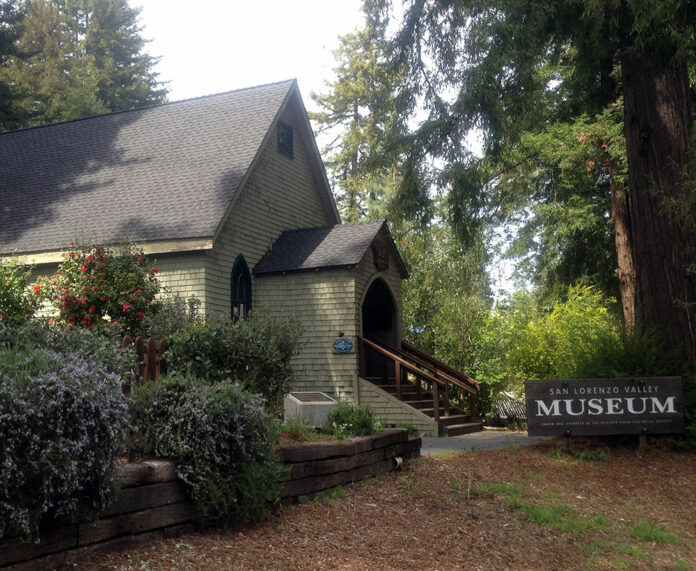For nearly 15 years, Lisa Robinson has had her hand in the development and trajectory of the San Lorenzo Valley Museum.
With two locations—one in Boulder Creek and the other in Felton—Robinson oversees both venues and works closely with her staff to arrange exhibits, write grant requests and provide educational nourishment to students from all over Santa Cruz County.
Now, Robinson’s role as SLV Museum Board President is evolving again, and she’s looking toward the future.
Enter “Museum From Home,” the answer to Covid-induced reductions in in-person visits. In addition to a Facebook page (facebook.com/slvmuseum), website (slvmuseum.org) and YouTube channel (@sanlorenzovalleymuseum4884), Robinson is taking the museum online with a fresh look at exhibits, documents and art that helped to shape the heritage of the San Lorenzo Valley.
“Covid pushed us to make this change because we needed to stay connected with our community. We have been operating on multiple platforms, but it made much more sense for our efforts to coalesce around a single medium,” Robinson said. “Our partnership with Google Arts & Culture allowed us to bring our collections online, so Museum From Home will be the one place that online visitors can go to view and enjoy our work.”
Some of the archives of the museum can be fairly unwieldy, so using Amazon’s S3 platform allows museum staff to have troves of old documents scanned for digital viewing. One such example is the newsletter/newspaper created exclusively by students from the long-closed Boulder Creek High School (BCHS).
After the Mountain Echo was disbanded (the publication ran aground in 1918), students from BCHS banded together to create a newsletter for the community. They managed to get hold of a printing press, named their newest publication “Community,” and starting in 1922, had terrific success with the distribution of the paper.
Currently, SLV Museum has about 50 copies of the publication in its archives.
“We were fortunate to get a grant from the California State Library called ‘California Revealed’ to have those items professionally scanned and placed online,” Robinson said.
Documents like those, says Robinson, are the types of historical finds that she wants to see made available in the Museum From Home platform.
“Items like these are so important. If you look at the weekly publication of ‘Community,’ it really paints a picture of what life was like in Boulder Creek in the early 1920s,” Robinson said.
There was no other paper covering the area then, so the paper was a valuable asset to residents. In addition, Robinson said that the student writers were not only reflecting on local news, but national happenings as well.
“You get a high school student’s perspective on national events, which is different than other publications,” she said.
Robinson added that some of the more popular exhibits, such as “Birth Happens,” will be made available in multiple ways online. For instance, the “Birth Happens” exhibit featured not only artifacts from the history of midwifery in Santa Cruz County, but also oral histories, captured as audio and video recordings, telling the stories of midwives and doulas who have worked locally.
“The museum produced the exhibition; we could take those assets and just produce an online exhibit, but really what we want to do is align with the principals of ‘Birth Happens’ to ensure that the material is handled with respect towards everyone involved,” she said.
Robinson is quick to celebrate one of the results of the exhibit that was on display in the fall of 2021. One of the “Birth Happens” team members is working with Cabrillo College, and thanks to her efforts, there will be a doula program at Cabrillo.
Robinson said that the college will focus on training doulas for the new initiative that will allow anyone receiving Medi-Cal to be eligible for a doula. (The California Department of Health Care Services added doula support to its roster of benefits on Jan. 1 of this year.)
Overall, Robinson is thrilled with the direction the museum is heading, although there has been a slight bump in the road. Nicole Berridge had been the Executive Director of the Museum since April 2019, but the CZU Fire impacted her area’s water system, and Berridge needed to focus on ways to protect the fragile ecosystem in her community.
While the Director’s position at the Museum has been open for some time, Robinson said they’re getting very close to making an offer to a new candidate, and are hopeful that they can announce the Museum’s new steward by the end of January.
In the interim, Robinson invites locals to learn more about what the museum has to offer.
“Allowing for online visitors will open up our Museum to a very broad audience, but will also help to serve our local community,” Robinson said. She points to mid-January as reference. “We’re supposed to have several classes from local schools come visit us next week, but the weather may be a deterrent. In that case, it’s helpful to have an online platform where students can still learn about the San Lorenzo Valley’s history,” she added.
Ultimately, Robinson is grateful for the local support of the Museum, but reminds readers that they operate entirely on the generosity of the community and the grants they secure for special projects.
“It would be great to be able to grow, and to have more staff. I look at other organizations, like the Museum of Natural History, and that’s my goal—have more paid staff to put the professionalism in place to operate and expand our school program,” she said. “We always welcome the community’s support in the operation of our programs.”
For more information on how to get involved with SLV Museum, visit slvmuseum.org.














